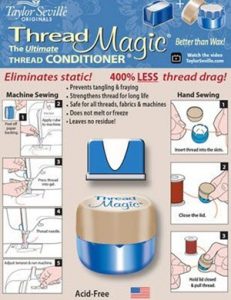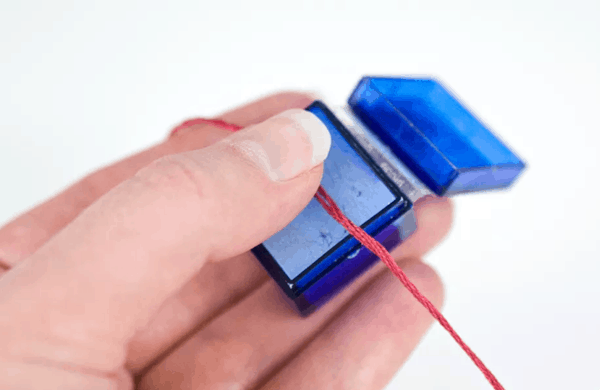In my last article, I wrote about storing your threads (floss) in such a way that they would remain easy to find, store and identify – to spare the frustrations of losing important shades of thread just as you needed them. Today, I’m going to focus on another challenge relating to threads – that is how to prevent and deal with tangles and knots, which is my idea of thread heaven…

Even the most experienced stitcher will occasionally feel the thread starting to tangle. It can seem that the best way of releasing the tangle is to pull at the thread, hoping that the knot will loosen before the thread breaks. At best this is a gamble that may or may not work. And when it fails can be frustratingly tricky to fix.
Even if the knot releases itself, it is likely that the thread will be tightened and that the fabric will pucker under the strain of the frustrated tugging. The thread will be damaged and frayed if a lot of effort is required to pull the knot out.
[emember_protected for=”2-3-4-5-6-7-8-9-10-11-12-13-14″]
How to prevent knots and tangles
We never want the above to happen, so here are some tips that will reduce the probability of these tangles and knots from forming in the first place.
Three tips for handling tangles
1. For tackling knots and tangles, you already have the best tool in your hand – your stitching needle. Use the tip of the needle and work slowly and gently to remove any knots.
Begin by placing your needle in the middle of the loop. Then pull up on the loop and then pull down on one end of the floss. If this doesn’t work, then pull down on the other end of floss. That should loosen the knot. Be careful not to use a lot of force.
When you have really stubborn tangles, usually the quickest way out of the problem is to carefully snip the stitches from the front of your fabric, and pull the cut threads from the back. Then re-stitch. If you make this decision early, you won’t lose much time at all.
2. All stitchers have their own preferred length of thread that they feel comfortable stitching with. If the thread is too long, the thread may tangle or fray. 18 inches is a recommended length.
Some inexperienced stitchers use longer strands in their needles, thinking this will save the time it takes to rethread the needle, but this can actually cause tangling instead.

Six individual strands of cotton thread.
3. Most cross stitch patterns (charts) call for two strands of a single colour or a blend of two different colours in the needle.
Before you start stitching, check the instructions for the number of strands to use. Pull each strand from the cut length separately, and then re-position the strands together. This might seem fiddly but will help to prevent tangling.
Three further tips for avoiding tangles
4. If you leave thread ends hanging, they are almost certain to get tangled up on the back of your project as you stitch. It’s not just that this makes the wrong side of your work look untidy, but after your piece is finished and framed, those tangles and knots will give a lumpy appearance on the right side too.
5. Thread is often likely to become twisted as you stitch. Avoid this by holding up your project after every seven or eight stitches, letting the needle dangle to take out any twisting.
Experienced stitchers also remember to twist the needle a half-turn as they bring it up in the fabric. This will help to prevent tangles from forming.
Introducing thread heaven
6. An old and well-tried way to prevent thread from tangling is to use beeswax to soften the thread (the downside of beeswax is its tendency to attract dirt over time). More recently, ‘Thread Heaven’ is a thread conditioner product that helps the thread to glide smoothly through the fabric.

Probably the most popular thread conditioner on the market.
Using a thread conditioner also helps release any static electricity in the thread, which is a main cause of tangling. Running your thread through a folded piece of a tumble dryer sheet can prevent any static build up too.
Note: Thread Heaven has been discontinued and although you can still find it in stores, it’s becoming more and more expensive. This is mainly due to the ever-shrinking supply available. It’s replacement is Thread Magic, which again is a thread conditioner. It makes the thread smoother so that it is less likely to snag, tangle, twist, or cause other friction problems.
Furthermore, you can also make your own thread conditioner, which saves you money. This short (4-5 mins) YouTube video shows you exactly how to make your own supply of thread conditioner, which works just as well as commercial brands and will last you a lifetime too:
In the video you’ve just seen, here are the items Milesy used that you’ll need in order to make your own thread heaven alternative. You should be able to get them from your local grocery store:
Mack’s silicone earplugs
Contact lens case.
Finally…
Today, I’ve shown you how to minimize a problem that can be a stitcher’s nightmare AND included details of how to make your own thread conditioner. Probably your key takeaway is “pay attention to detail”. With a bit of effort, knowledge, and care you really can make knots and tangles a thing of the past.
I hope you enjoyed this article and found it useful. I’d love to hear from you with any tips, in the comments section below, on how to prevent knots and tangles in your cross stitching. I always reply to all comments.
Happy – and tangle-free – Stitching!
Scarlet, “In the UK”.
[/emember_protected]
